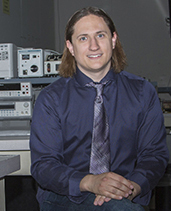When performing diagnoses, pathologists rely heavily on qualitative chemical staining techniques that date back to the 19th century to detect signs of disease in tissue biopsies, to serve as bases for treatment plans and to measure disease progression in patients.
Medical schools train physicians extensively to recognize microscopic molecular and structural abnormalities using colorful patterns created when chemical stains are applied to tissue samples.
“Chemical staining has disadvantages, though,” said David Mayerich, assistant professor of electrical and computer engineering at UH Cullen College of Engineering. “The method is sensitive to many factors that are difficult to control, so pathologists in different labs can get different results when they analyze the same tissue sample.”
In a collaborative project, Mayerich has developed a technique to produce digital versions of popular chemical stains, relying instead on quantitative molecular information collected using mid-infrared light. Their research published in the March edition of the journal Technology. The team hopes to provide technology that can either complement or replace current chemical staining, resulting in more reliable histopathological diagnoses and fewer mistakes.
Mayerich, who joined the UH faculty less than a year ago, arrived with a three-year $750,000 grant from the National Institutes of Health that he earned as a postdoc at the University of Illinois. He has since earned an additional $2 million grant from the Cancer Prevention Research Institute of Texas to continue his scholarly pursuits. The collaborative project includes Rohit Bhargava, professor of bioengineering at the University of Illinois at Urbana-Champaign, and Michael Walsh, professor of pathology at the University of Illinois at Chicago, among other researchers.
The primary focus of the project is cancer detection in needle biopsies, Mayerich said. Currently, pathologists place tissue samples in wax blocks and dye sections with contrasting stains, such as hematoxinylin-eosin (H&E), to examine them for molecular features and patterns.
Uniformity is difficult to achieve in histopathology because of the complicated chemical processes, Mayerich said. Some laboratories use automated systems that attempt to support pathologists by achieving color consistency in application of chemical stains to tissue samples. However, numerous variables that are difficult to control still influence results, and diagnoses of the same tissue sample by different pathologists can vary.
Mayerich and the other researchers aim to diminish or eliminate the detrimental effects of variables, such as different environments and tissue preparation methods, inherent in chemical staining.
“We want to duplicate these chemical stains digitally to enable pathologists to use their years of training and experience with better results,” Mayerich said. “The goal is to replace chemical stains whenever possible with digital versions that give pathologists information that they can trust more.”
The researchers are simultaneously developing an automated, quantitative system for disease detection. They are utilizing mid-infrared microscopy to identify and classify exact chemical compositions of various tissues to which they can apply their universal digital stains.
“We shine beams of light through the tissue samples to determine their chemical composition, so we expect the same diagnoses when we apply digital stains to the same tissue images at different labs,” Mayerich said. “We get very accurate results based on tissue classification, so the results are very promising.”
Mayerich’s main role in the project is to create computer algorithms that automate the processes. He is training mid-infrared instruments to image tissue chemistry and to send the data to computers that apply digital stains and analyze results to determine diagnoses.
Unlike the chemical staining technique that destroys tissues, digital staining allows pathologists to apply different stains repeatedly to the same samples. Reliability and repeatability of histopathological diagnoses are the main focuses of the research, but the technology could also save laboratories costs associated with expensive chemical stains and specimen storage and spare patients the additional expense and discomfort of multiple biopsies.
“After initial equipment investments, the staining is basically free for laboratories,” Mayerich said. “They purchase the instrumentation that measures data, and they store the results on computer systems that are backed up so they never worry about losing them.”
However, some chemical features could be difficult to detect using mid-infrared microscopy but significantly clear using chemical staining. So laboratories could ideally incorporate a combination of the two technologies, Mayerich said.
“We don’t know how far we can take it yet,” Mayerich said. “We are creating as many digital stains as possible for each of the various types of tissues we classify.”
In the past, mid-infrared imaging required too much time to make much mainstream progress, but new, speedy laser instrumentation could remove that barrier. The University of Houston is acquiring mid-infrared imaging systems to aid Mayerich with his software development.
“I believe that recent advances in instrumentation combined with continued increases in computer resources are pushing this technology to the point where it can be clinically viable in the near future,” Mayerich said.
